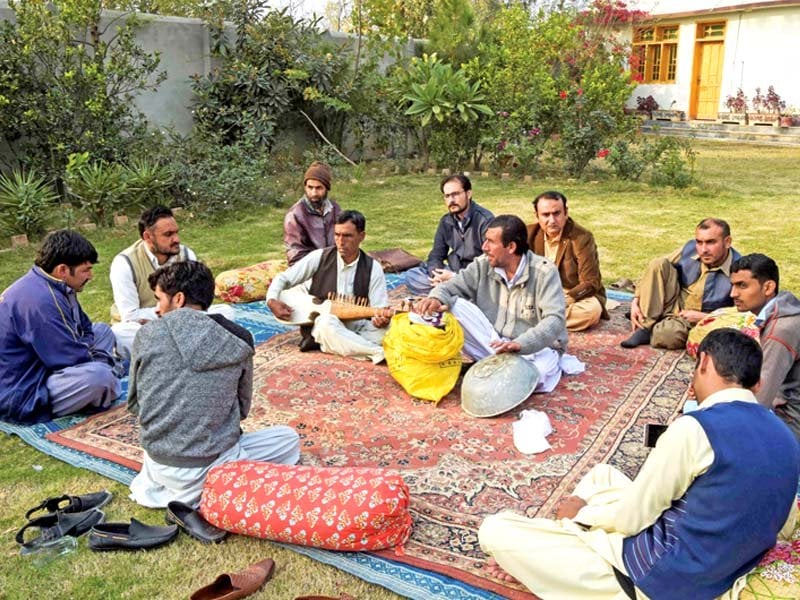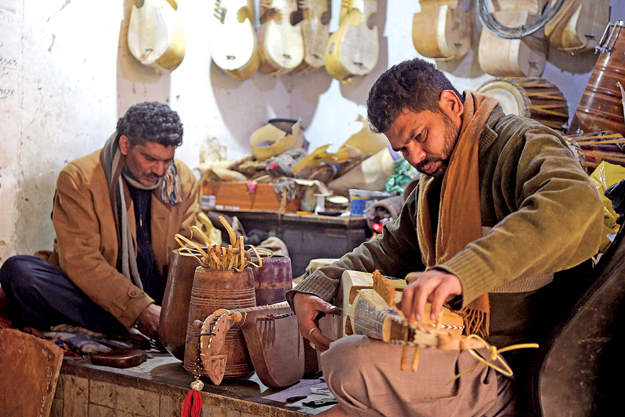
But, as security improves, the centuries-old tradition is staging a comeback.
Performances, which once took place in secret, are returning. Shops selling instruments are open and thriving again, while local broadcasters frequently feature rising Pashto pop singers in their programming.
And now, up and coming bands such as Khumariyaan from Peshawar have reached rare, nationwide acclaim after appearing on the popular Coke Studios broadcast, where they fused traditional sounds with modern tastes -- spreading Pashtun music far from its native homeland.
"Music is the spice of life... it has been a part of our culture from time immemorial," says Farman Ali Shah, a village elder and Pashto poet in Warsak village near the provincial capital.
Pashtun music is characterised by the rabab, a Central Asian stringed instrument, played to the beat from tablas (drums), with songs salted with florid lyrics describing the pain of unrequited love or calls for political revolution.
"For centuries, we were a liberal society," explains rabab player and member of the National Assembly (NA) Haider Ali Khan from the scenic Swat Valley.
"We love our religion but at the same time we love our traditional music."
Yet the slow creep of extremism had been threatening that tradition for decades.
Beginning in the 1970s, more hard-line Islamist movements started gaining influence in the Pashtun areas along the border with Afghanistan, promoting strict interpretations of the religion including dismissive takes towards music.
The shift towards violent extremism intensified with the 1979 Soviet invasion of Afghanistan and the later Taliban regime of the 1990s.
After the US invasion of Afghanistan in 2001 to topple the Taliban, militancy erupted across the Durand Line, especially in K-P. A Pakistani Taliban movement soon formed and took control of ex-Fata and parts of K-P. The areas which they did not control reeled from the fear of a Taliban strike.

"The extremists were killing artists and singers in the society to create fear," explains singer Gulzar Alam, who was attacked on three separate occasions and later fled the country, fearing for his life.
"If you remove culture from a community, tribe, or ethnic group, the community will be eliminated."
Public performances were all but halted as waves of suicide bombers unleashed havoc.
CD markets were bombed, instrument shops destroyed, and musicians were intimidated or either outright targeted.
Singers and musicians fled en masse, while others were gunned down.
A few diehard connoisseurs continued to invite musicians to play in private shows at hujras and weddings, albeit without large sound systems that could possibly attract the unwanted attention and wrath of militants.
"They were asking people to stop music but villagers never accepted them," says Noor Sher from the Sufaid Sang village, where his family has been making rababs by hand for 25 years.
Amid the chaos, the art form persevered thanks to an increasing number of Afghan musicians who —fleeing violence in their own country and resettled in Peshawar and other places — opened music schools that kept the tradition alive.
In 2014, the Army launched an intense operation to push the militants out. Security in the country has dramatically improved in the years since.
"Now the situation is good, very good. We can play anywhere, whenever people invite us," says rabab player Akhtar Gul during a performance at a hujra – a traditional Pashtun community space.
As music has returned to its traditional settings in K-P and its merged districts, slick broadcasts like Coke Studio have helped introduce Pashtun acts to millions of music fans across the world.
Many still remain cautious in K-P, however, fearing the gains are tenuous at best. Some interviewed refused to criticise militants, fearing their eventual return.
And while the insurgents may have been pushed back, conservative attitudes toward music continues to resonate in the area.
For 24-year-old Abdul Latif, his love of playing the rabab is largely kept secret from his family who consider such instruments to be out of sync with Islam.
"This is a part of the Pashtun culture but I think my family lacks awareness," he says.
For musicians such as Gulzar Alam, who were forced to flee their homes, the damage runs deeper.
"It takes a lot of time, to set the mind or brain of the artists free from fear," says Alam from Kabul where he is waiting for a response to an asylum request with the United Nations.
"You can change the policy of a government with a stroke of a pen, it does not take much time," adds the lawmaker Khan.
"But to change the mindset you have created in two or three decades, it is not easy for that mindset to change."
Published in The Express Tribune, February 18th, 2020.















1714029027-0/Tribune-Collage-Feature-Images-(11)1714029027-0-270x192.webp)
1714027629-0/Ranbirtransformation-(1)1714027629-0-270x192.webp)


















COMMENTS
Comments are moderated and generally will be posted if they are on-topic and not abusive.
For more information, please see our Comments FAQ